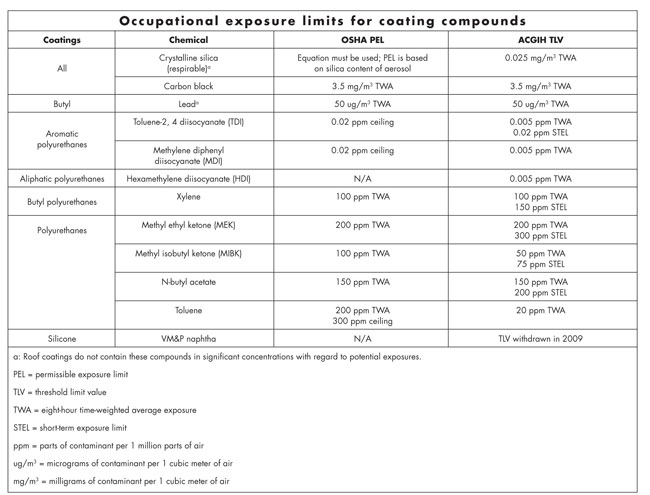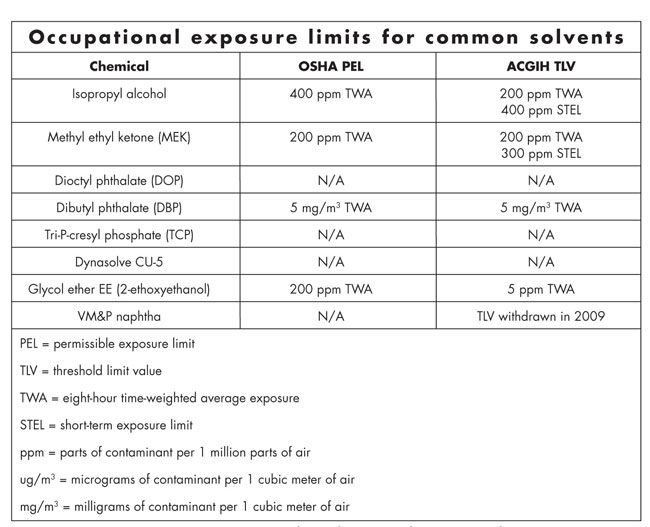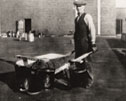Whether you've been installing spray polyurethane foam (SPF) roof systems for more than 30 years or are considering adding the product to your service portfolio, you probably could benefit from an update on the safe handling and application of chemicals for SPF roof systems.
When proper precautions are taken, chemicals, coatings and solvents used during SPF roofing applications can be used safely without adverse health effects. Federal, state and some local agencies require proper precautions to be followed on job sites when handling certain chemicals. These include using engineering controls, proper work site practices, using appropriate personal protective equipment (PPE), and reading and understanding product labels and material safety data sheets (MSDSs).
Before beginning an SPF job, think of all the ways contact with chemicals could occur. Remember, this includes every step of the job, from site preparation (which may involve cleaning solvents, coatings and dust exposure) to foam application, coating of the foam surface and cleanup at the end of a job.
MSDSs
Before beginning any job, thoroughly read the MSDS for each product used. Suppliers are required to provide MSDSs for each chemical they produce, and MSDSs usually can be downloaded from suppliers' websites. These documents provide important information about safe handling of chemicals, including hazard information, PPE and engineering controls used to work safely with a chemical.
Employers are required to make an MSDS "readily accessible" for each chemical used on job sites, and applicators and helpers need to be familiar with the information contained in MSDSs. In addition, it is a good idea to review MSDSs with building owners, general contractors, homeowners or anyone in the vicinity before SPF product application.
SPF chemicals
Certain chemicals used during SPF application may be hazardous when not properly handled and applied. These include the A and B chemicals, coatings used to protect the foam, and solvents used to prepare surfaces and clean equipment following application.
The two basic chemical groups that make up SPF systems are polymeric methylene diphenyl diisocyanates (MDI), commonly called the A side, and polyol resin blend, known as the B side. When these chemicals react, polyurethane is formed. When SPF is applied, the A and B sides are mixed in a 1:1 ratio and applied using a fine spray.
MDI can irritate the skin, mucous membranes, eyes and respiratory tract. Overexposure also may cause skin and respiratory sensitization. Sensitization is an allergic reaction that can cause an individual to be more responsive to a chemical exposure at progressively lower concentrations, even below concentrations considered safe for most people.
Sensitization symptoms, which can be life-threatening, may include coughing, wheezing, chest tightness, shortness of breath or even asthma. Skin sensitization symptoms include redness, itching, swelling and/or rash. Once a person is sensitized, a small exposure may trigger sensitization symptoms. Sensitized workers may not be able to work around SPF or other MDI-containing products.
Polyol resin is blended with several other chemicals to create SPF. These proprietary B-side blends vary among manufacturers and SPF types (low-density open-cell, medium-density closed-cell and roofing foams). A B-side formulation typically includes the polyols—the principal ingredients—and smaller amounts of amine and/or metal catalysts, blowing agents, surfactants and flame retardants. Because polyol resin systems are purchased pre-blended, manufacturers provide lists of hazardous materials and their relative concentrations via MSDSs, which also provide recommendations for PPE use associated with B-side chemicals.
Chemical exposure levels
Exposure levels are air concentrations of chemicals that are expressed as parts of the chemical in the air per million parts (ppm) of air or milligrams of the chemical per cubic meter of air (mg/m3). Typically, vapors and gases are shown in terms of ppm and particulates (dusts, fumes and smoke) are shown as mg/m3. Either expression can be used for vapors and gases but not particulates.
The Occupational Safety and Health Administration (OSHA) Personal Exposure Limit Ceiling (PEL-C) for airborne MDI is 0.02 ppm (0.2 mg/m3). A ceiling limit is a material's maximum concentration that should never be exceeded.
The American Conference of Governmental Industrial Hygienists (ACGIH) recommends an eight-hour time-weighted average (TWA) exposure limit for airborne MDI of 0.005 ppm (0.05 mg/m3). A TWA exposure is the average exposure during an eight-hour workday, which takes into account the high and low exposures in most industrial work areas.
OSHA's PELs in construction are based on threshold limit values (TLVs) set in 1970 by ACGIH. OSHA hasn't updated the levels except for specific standards related to some hazardous substances. The 0.05 mg/m3 threshold is ACGIH's updated TLV.
OSHA and ACGIH exposure limits for MDI are relatively low. They intend to prevent the development of irritation, sensitization and other adverse reactions in workers. Remember, MDI in general has poor odor-warning properties, which means most individuals cannot detect the odor at airborne levels at or below the PEL or TLV. In other words, if you smell it, you probably have exceeded the exposure limit.
There have been numerous MDI exposure studies conducted during SPF insulation and roofing applications. Although air MDI levels generally are higher for interior SPF insulation applications than exterior SPF roofing jobs, MDI levels for both applications can exceed exposure limits in some cases. For this reason, certain safety precautions, which I will discuss later, should be followed during SPF application.
Neither OSHA nor ACGIH have established exposure limits for polyols in SPF systems. However, some additives (for instance, some amines and metal catalysts) have established exposure limits in their pure, unblended forms.
SPF coatings
Foams will degrade when exposed to ultraviolet (UV) rays, so exterior SPF applications typically are covered with durable, UV-resistant coatings.
There are five basic categories of coatings used in SPF roof systems: silicone, polyurethane, acrylic, polyurea and butyl. Specific properties of each type of coating are discussed in SPFA AY-102: A Guide for the Selection of Elastomeric Protective Coatings Over Sprayed Polyurethane Foam, which can be downloaded for free from the Technical Documents section of SPFA's website, www.sprayfoam.org. Each is unique in chemistry and has specific hazards associated with it. Carefully read and understand the health and safety information provided by coating suppliers.
Most coatings are mixed with one or more organic solvents. The most common of these are toluene, petroleum distillates, xylene, methyl ethyl ketone, varnish makers and painters (VM&P) naphtha and n-butyl acetate. All of these can depress the central nervous system.

Figure 1: OSHA PELs and ACGIH TLVs for the most common chemicals used in SPF roof coatings
Symptoms of overexposure include headache, nausea and vomiting followed by unconsciousness at higher levels of exposure. There also are reports of permanent nervous system damage resulting from long-term overexposures to many common organic solvents. Direct contact with such solvents also can cause defatting, drying and cracking of the skin.
Because of the great number of chemicals in coating compounds, it is not possible to list the PELs for each ingredient. Figure 1 lists the OSHA PELs and ACGIH TLVs for the most common chemicals used in SPF roof coatings. The list does not include all products, so read the MSDS thoroughly for each product used during SPF applications.
Solvents
Solvents commonly are used in site preparation, equipment maintenance and cleanup after SPF and coatings applications. Solvents may include isopropyl alcohol (rubbing alcohol), methyl ethyl ketone and VM&P naphtha. Their exposure limits are shown in Figure 2.

Figure 2: Exposure limits for solvents commonly used in SPF and coatings applications
Safety precautions
To ensure a safe job site, you can implement several safety measures, such as engineering controls.
Engineering controls are changes in a project's design intended to reduce the potential for worker exposure. The best time to consider engineering controls is before a job starts.
For SPF applications, this means having proper ventilation in the spray zone or the immediate area where SPF is being applied.
For interior SPF applications, ventilation systems and containment are control measures that can help reduce potential exposure of workers in the immediate spray area as well as adjacent areas.
For SPF roofing applications, natural movement of outdoor air is considered to be sufficient and ventilation is not required.
Hygiene
Prohibiting food storage, preparation or consumption in an area where SPF chemicals are used can help prevent accidental chemical ingestion. Smoking or chewing tobacco or gum could result in accidental ingestion of SPF chemicals by workers through the transfer of chemicals from hands or clothing to the mouth. Before SPF applicators eat or smoke, they should wash their hands.
Skin protection
PPE is used whenever there is the possibility of direct contact with SPF chemicals. The appropriate protective clothing and equipment will vary depending on exposure potential.
For example, because overspray is difficult to prevent, spray applicators should wear personal protective clothing, gloves and respiratory protection.
It is important to refer to the MSDS for the appropriate gloves to be used with a material. Not all gloves provide adequate protection against chemical exposure. Gloves made of nitrile, neoprene, butyl or PVC generally provide adequate protection against A-side materials.
Eye protection
Eye protection can prevent contact with splashes of liquid SPF chemicals, accidental sprays of reacting foam, aerosols and vapors that are likely to be present during spraying, and airborne particulate associated with sanding and grinding operations. The type of eye protection needed will depend on the activity.
For example, for exterior applications, safety glasses with side shields may be sufficient for the applicator and helpers, but for interior applications, a full-face respirator or hood can provide eye protection. People handling liquid SPF chemicals in open containers can protect their eyes by wearing chemical-type safety goggles or safety goggles with face shields.
Respiratory protection
OSHA's Respiratory Protection Standard (29 CFR § 1910.134) sets forth requirements for a respiratory protection program. The Center for the Polyurethanes Industry has created a Model Respiratory Protection Program that can help SPF contractors develop a respiratory protection program. The program, divided into 10 steps, provides user-friendly documents for facilities and guidance on appropriate respirators, respirator use, storage, fit and evaluation.
OSHA requires employers to provide a medical evaluation to determine an employee's ability to use a respirator before the employee is fit tested or required to use the respirator. Requirements for fit testing and training also apply. These are important so respirators are used properly. OSHA prohibits people who have sideburns, mustaches, beards or facial hair that interfere with the face piece seal or respirator valve function from wearing tight-fitting respirators. Consult suppliers' MSDSs for respiratory protection recommendations.??CONTINUES ON PAGE 62
Typically for SPF roofing applications, applicators may choose to wear an air-purifying respirator (APR) or a supplied air respirator (SAR).
APRs generally are appropriate for exterior applications, and SARs typically are used for interior applications. APRs remove contaminants from the air by mechanical (filter) or chemical (absorbent) means. APRs may be used when spraying polyurethane foam but only with adherence to OSHA's Respiratory Protection Standard. Full-face air-purifying respirators offer greater protection and also provide eye protection.
If an APR is selected, OSHA requires a change-out schedule based on objective information or data. The change-out schedule is critical because of SPF's odorless nature-workers cannot taste or smell when a filter is due for a change-out. The basis for the change-out schedule must be described in the written respirator program.
For spray applications, workers should be sure to use the proper cartridges with APRs. In most cases, a combination organic vapor/particulate (rated P100) cartridge is used. These cartridges are color-coded; look for black and magenta (purple) colors on the cartridge body. If you have any doubt about which cartridge to use, contact the supplier of the respirators for advice.
Because SPF roof system installation takes place outdoors, APRs are an acceptable form of respiratory protection provided they meet the requirements. Although exposure to MDI and other chemicals can vary by task, typical APR cartridges are replaced every eight hours or once per shift for everyone at a job site.
SARs consist of full-face masks, hoods or helmets to which air is supplied through a small-diameter hose connected to an air source. SARs can provide breathing air from a compressor, bottled (compressed) air, or a low-pressure pump attached to an air-line hose or self-contained breathing apparatus in which a worker carries the bottled air. SARs also are called Type C systems or air-line respirators. SARs typically provide the greatest protection for wearers, but air supply lines required for most of these devices present an additional trip hazard when working on roofs.
Property protection
It is important to realize the effects of an SPF job are not limited to your employees. Building occupants, other tradespeople present and occupants of neighboring buildings also can be exposed to SPF chemicals. This is particularly significant for commercial or new construction settings where other portions of a building may be occupied.
To avoid exposing others to overspray, do the following:
- Determine the potential for overspray damage in advance.
- Discuss any overspray potential with the building owner, and make arrangements to relocate vehicles or protect surfaces (such as windows, doors, equipment or building exterior) from overspray.
- Consider the wind speed. Wind speeds exceeding 15 mph may affect foam application as well as increase the risk of overspray. When the wind speed is less than 15 mph, applicators typically use windscreens to minimize overspray.
- Have a plan in place for when overspray damages occur.
- Train all employees in overspray prevention.
During roof system preparation and application of primers, foam and coatings, HVAC systems typically are shut down (this must be coordinated with building engineering staff). This helps prevent the spread of dusts, aerosols and/or vapors into interior spaces. Once an HVAC system has been shut down, seal the air intakes with plastic sheeting and tape. Plastic sheeting typically remains on the air intakes for at least two hours after foam application and potentially longer for coatings. After this time, an HVAC system can be restarted.
Following application of SPF in interior applications, workers in adjacent areas or building occupants may be exposed to SPF chemicals even after spraying has stopped. Reoccupancy time is the amount of time to wait before allowing other workers or occupants to re-enter the spray area. Reoccupancy time depends on a number of factors, including SPF formulation, the amount of foam applied per volume of space and the degree of ventilation.
Evaluation reports for many types of building products, including SPF insulation, often include the suggested reoccupancy time, which varies. For an interior application using a two-component high-pressure SPF, 24 hours is common. For hospitals and schools where SPF roof systems or exterior SPF is applied, the same 24-hour reoccupancy time is common. Contact your SPF supplier for guidance regarding reoccupancy time.
A safe installation
I have provided basic chemical safety precautions to consider during SPF roofing applications. Following are a few key points to remember:
- PPE, including skin and clothing protection, gloves, and eye and respiratory protection, is needed for workers in the immediate spray area, including applicators and helpers.
- OSHA requires employers to institute a respiratory protection program when respiratory protection is needed to protect employees' health.
- It is a good idea to inform building owners about potential hazards present during SPF application.
- As part of job-site preparation, develop steps to protect occupants as well as workers from potential chemical exposure.
Rick Duncan, Ph.D., P.E., is the Spray Polyurethane Foam Alliance's technical director.
Additional resources
To learn more about chemical health and safety for applicators and helpers, refer to the following resources:
- SPF chemical suppliers. Chemical suppliers provide material safety data sheets for all their chemical products. In addition to foam and coatings, suppliers offer hands-on training programs for equipment and materials that include information about chemical safety.
- Spray Polyurethane Foam Alliance (SPFA). SPFA provides accreditation training programs to members and nonmembers. SPFA training includes chemical safety training, and this year, SPFA will offer a full-day safety training program that will include chemical safety training and general job-site safety information from the Center for the Polyurethanes Industry. Information about SPFA accreditation courses can be found at www.sprayfoam.org.
- Center for the Polyurethanes Industry (CPI). CPI, working with SPFA, launched a new website providing a wealth of information about SPF chemical safety, including posters and guidance documents for applicators and contractors. CPI also offers an online chemical safety training program available to the general public. For more information, visit www.spraypolyurethane.com.



